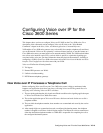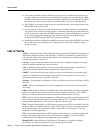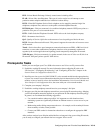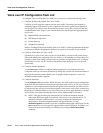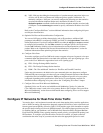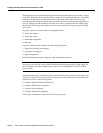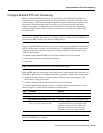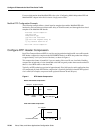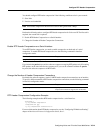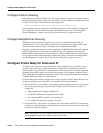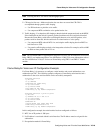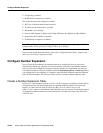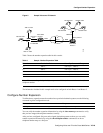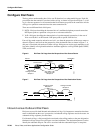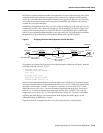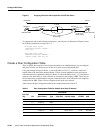
List of Terms
VC-14
Voice, Video, and Home Applications Configuration Guide
5 The session application then runs the H.323 session protocol to establish a transmission and a
reception channel for each direction over the IP network. If the call is being handled by a PBX,
the PBX forwards the call to the destination telephone. If RSVP has been configured, the RSVP
reservations are put into effect to achieve the desired quality of service over the IP network.
6 The CODECs are enabled for both ends of the connection and the conversation proceeds using
RTP/UDP/IP as the protocol stack.
7 Any call-progress indications (or other signals that can be carried in-band) are cut through the
voice path as soon as end-to-end audio channel is established. Signaling that can be detected by
the voice ports (for example, in-band DTMF digits after the call setup is complete) is also trapped
by the session application at either end of the connection and carried over the IP network
encapsulated in RTCP using the RTCP APP extension mechanism.
8 When either end of the call hangs up, the RSVP reservations are torn down (if RSVP is used) and
the session ends. Each end becomes idle, waiting for the next off-hook condition to trigger
another call setup.
List of Terms
ACOM—Term used in G.165, “General Characteristics of International Telephone Connections and
International Telephone Circuits: Echo Cancellers.” ACOM is the combined loss achieved by the
echo canceller, which is the sum of the Echo Return Loss, Echo Return Loss Enhancement, and
nonlinear processing loss for the call.
Call leg—A logical connection between the router and either a telephony endpoint over a bearer
channel or another endpoint using a session protocol.
CIR—Committed information Rate. The average rate of information transfer a subscriber (for
example, the network administrator) has stipulated for a Frame Relay PVC.
CODEC—coder-decoder. Device that typically uses pulse code modulation to transform analog
signals into a digital bit stream and digital signals back into analog signals. In Voice over IP, it
specifies the voice coder rate of speech for a dial peer.
Dial peer—An addressable call endpoint. In Voice over IP, there are two kinds of dial peers: POTS
and VoIP.
DTMF—Dual tone multifrequency. Use of two simultaneous voice-band tones for dial (such as
touch tone).
E&M—E&M stands for recEive and transMit (or Ear and Mouth). E&M is a trunking arrangement
generally used for two-way switch-to-switch or switch-to-network connections. Cisco’s E&M
interface is an RJ-48 connector that allows connections to PBX trunk lines (tie lines).
FIFO—First-in, first-out. In data communication, FIFO refers to a buffering scheme where the first
byte of data entering the buffer is the first byte retrieved by the CPU. In telephony, FIFO refers to a
queuing scheme where the first calls received are the first calls processed.
FXO—Foreign Exchange Office. An FXO interface connects to the PSTN’s central office and is the
interface offered on a standard telephone. Cisco’s FXO interface is an RJ-11 connector that allows
an analog connection to be directed at the PSTN’s central office. This interface is of value for
off-premise extension applications.
FXS—Foreign Exchange Station. An FXS interface connects directly to a standard telephone and
supplies ring, voltage, and dial tone. Cisco’s FXS interface is an RJ-11 connector that allows
connections to basic telephone service equipment, keysets, and PBXs.
Multilink PPP—Multilink Point-to-Point Protocol. This protocol is a method of splitting,
recombining, and sequencing datagrams across multiple logical data links.



